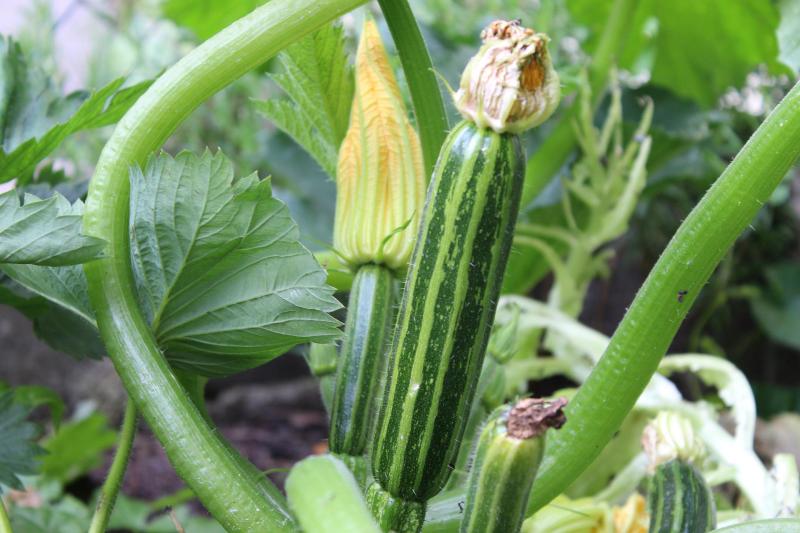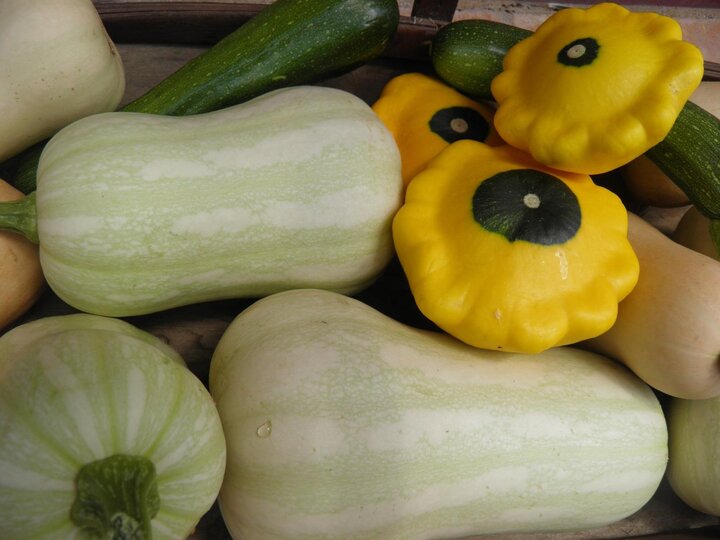Sarah Browning, Nebraska Extension Educator

Summer squash, like this zucchini, is a cucurbit of the species Cucurbita pepo. Image from Pixabay.com
The growing season is in full swing and gardening questions abound! Including questions about pollination and its effects in the vegetable garden, so here is a quick look at pollination and how it will - or won’t - affect the plants in your garden.
Can pumpkins be planted near cucumbers, or will they cross-pollinate and cause problems with this summer’s fruits? Each summer, Extension offices receive calls from clientele wondering if their plants have crossed with something else to create a weird hybrid. In this particular instance, the answers are “yes” and “no.
What is Pollination?
Pollination occurs when a grain of pollen, containing one-half the genetic material needed to create a new seed, is transferred to a flower’s ovule, the egg-containing part of a flower, which provides the second half of DNA required for a viable seed to form. Pollen is the contribution of the male parent and the female parent provides the ovule.
Self-pollinated crops, such as beans and peas, have evolved strategies to ensure self-fertilization. Often their flower structure prevents the easy movement of pollen outside the flower or flowers may be pollinated before they even open! Self-pollination often results in plant lines with very consistent DNA, which ensures new plants grown from saving seed will be almost identical to the parent plants.
Cross-pollination occurs when pollen from one plant fertilizes the ovules of another plant. Some plants cannot set viable seed without cross pollination, as is the case with broccoli and many apple cultivars. Cross-pollination happens through the actions of pollinators, such as insects and other animals, or by wind blowing pollen from plant to plant. In the home vegetable garden, tomato, watermelon and cucumbers are cross-pollinated by insects and sweet corn is wind pollinated.

Which Plants Can Cross-pollinate?
With very few exceptions, only plants within the same genus can cross-pollinate. Within the Cucurbita genus, only plants of the same species can cross-pollinate. Pumpkins are in the genus “Cucurbita” and the species “pepo”, while cucumbers are in the “Cucumis” genus and “sativus” species.
As you can see below, pumpkins and cucumbers are not in the same genus, so they cannot cross-pollinate. That means they can be planted right next to each other, and gardeners will see no strange effects in the fruits. However, pumpkins and some types of squash can cross-pollinate because they are in the same species.
- Cucurbita pepo – Summer squash (both zucchini and yellow summer squash); acorn, Delicata, patty pan and spaghetti squash; pumpkins and gourds are all in the same species.
- Cucurbita maxima – winter squash, such as buttercup, banana, Hubbard and turban squash
- Cucurbita moschata – winter squash, such as butternut, cushaw and winter crookneck squash
- Citrullus lanatus – watermelon
- Cucumis melo – cantaloupe, honeydew
- Cucumis sativus – cucumber
Pollen Effects on Plant
Fruits - The pollen source does not, no matter if the plant is self- or cross-pollinated, affect the look or flavor of a new fruit, such as an apple, tomato or watermelon. The part of the fruit we eat originates from the female plant’s ovule and has the female’s genetic traits no matter what the male pollen source. However, seed saved from cross-pollinated plants will result in a varied array of fruit characteristics in the next generation due to the mixing of female and male genetic traits.
Vegetative plant parts - If the plant part we eat is a vegetative structure - like broccoli, lettuce, beets or potatoes – the plant’s characteristics are dictated by the genetics of both the male and female parents, which the plant received last year as seeds were fertilized. Gardeners only see the effects of pollen source when saving seed from year to year. In the first year of seeding, no effects from pollen source are seen, but in subsequent years plants grown from saved seed resulting from cross-pollination will not reliably have the same characteristics as the original parent.
Seeds - In some cases, the plant part we eat is actually the seed, such as beans, peas or kernels of sweet corn. Seed characteristics – size, color, texture, flavor – are affected by the pollen source because seeds are the result of the mix of female and male genetic traits. Beans and peas are self-pollinated, so introduction of a new male pollen source is uncommon.
However, sweet corn, which is cross-pollinated by wind, is very susceptible to changes caused by pollen source. All types of corn readily cross-pollinate. Sweet corn must be isolated from field corn, popcorn and ornamental Indian corn either by location or flowering dates, or the ears harvested will have kernels of different types. A distance of 400-yards or planting so that maturity dates are one month apart, is necessary to create isolation and prevent cross-pollination between cultivars.
White and yellow sweet corn types also cross-pollinate, but the effects are minimal if they all have the same sweetness gene (sh2 – supersweet or shrunken, SE - sugary enhanced or su - sugary). Corn cultivars with the SE gene may benefit from isolation from other corn sweetness types, but it is not absolutely necessary.

Weird Hybrid
So what about the weird-shaped pumpkins, squash or gourds appearing in the garden this year? They were not caused by a funky pollen source. These fruits are usually either 1) the result of plants grown from seeds saved from last year’s fruits, 2) the product of volunteer plants from fruits (possibly diseased or broken ones) left in the garden the previous year, 3) infected with a virus or 4) rarely an off-type seed mixed into a seed packet.
Images
- Butternut and patty pan squash are separate Cucurbita species and will not cross pollinate. Image from Pixabay.com.
- Virus infection is a potential cause of abnormalities in the vegetable garden, as with this watermelon mosaic virus infected yellow summer squash. Image by Gerald Holmes, Strawberry Center, Cal Poly San Luis Obispo, Bugwood.org.